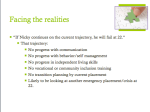Part 1 of “22at20, Deconstructed.” Over the next 3 weeks we will address each of the key takeaways that we discuss during our presentation; collaboration, early planning, creative visions. We hope you are able to take these ideas and share them with your team members, and create your own successful transition!

One of the early slides in the 22 at 20 presentation: “If Nicky continues on the current trajectory, he will fail at 22.”
Each time I do this presentation, one of the first things I say is that yes, this is one story – but listen carefully and I’m certain you’ll hear a number of things that ring familiar. One of those moments (I’m told) is when I make the statement that “given the trajectory that Nicky is on right now, (without making any changes) he will fail at 22.”
I usually have a handful of people nodding their heads at that statement, which tells me it hits home.
That trajectory for us was very scary. This is what we meant – here’s what was going on at the time in his residential placement:
- No progress with communication
- No progress with behavior/self management
- No progress in independent living skills
- No vocational or community inclusion training
- No transition planning by current placement
- Likely to be looking at another emergency placement/crisis at 22.
Now, you might not being looking at all these same issues, but there are very few students for whom the current trajectory is going to prepare them for adulthood. This may be something you’ve already thought of or this post might become your “aha” moment.
Nicky was just shy of 19 years old when we finally put these thoughts into words and approached our SPED Director at the time. We believe in the power of teamwork and experience has taught us the hard lesson of not leaping too quickly or reacting with emotion. We had a vested relationship and interest in his placement at that time and knew it would be important to start there – so, we approached them along with the Director, and expressed our concerns.
Unfortunately, we were met with negative responses about their belief in Nicky’s abilities to ever progress or be a member of any community. Again, you might not have this same experience – I hope for you that instead, your team will see your point and skip right to the kind of shift in planning we did DESPITE the placement, not together with them. We didn’t skip a beat – we turned around, kept our firm beliefs in our son and his beautiful spirit and intelligence (the real Nicky, not their version) and began laying the ground to change the trajectory.
 The first thing we did was let our IEP team know that the IEP needed to reflect transition planning goals only – we were far behind where we should be (MA law says start at 14) and the clock is ticking. Because we have a guy with significant challenges, we needed every minute to count.
The first thing we did was let our IEP team know that the IEP needed to reflect transition planning goals only – we were far behind where we should be (MA law says start at 14) and the clock is ticking. Because we have a guy with significant challenges, we needed every minute to count.
Then we had to find out what exactly that meant (kinda important)…and we knew it had to be based on 2 things: Nicky’s true skills (current and realistically anticipated) and the environment he was going to. Let me explain.
For years someone on Nicky’s team would start talking about him learning money handling. Every time, we would send a shockwave through the meeting by saying “absolutely not.” Here’s why: Nicky has never learned 1:1 correspondence, so he hasn’t even learned to count. He cannot read. He has no concept of money. He is aggressive. So, what does money handling skills require? A concept of money in exchange for an item, basic math skills, basic number recognition, and the ability to physically give and receive things by hand with the absence of aggression. Let’s see…no, no, no, and sometimes not. What are the chances that Nicky will ever be in a store by himself? Zero. What positive reinforcement does Nicky get by ‘having his own money?’ Zero. He likes getting what he wants, period. TAKE IT OFF THE LIST!
This is just one example of a skill that is off the shelf, pre-packaged as something the professionals think is important. But none of our kids come pre-packaged, do they?
So what is important? We turned to the team to help answer, and toured other situations that were similar to our vision (there aren’t many). We wanted Nicky to be AS READY AS POSSIBLE to manage in his new home and new environments.
Every team member provided excellent suggestions. Because he was going to live in a private home with a caregiver and support staff, as many independent living skills as possible FOR NICKY were added to the list – he could already dress, shower, toilet, operate a computer, eat, drink, choose and access food or drink, set a table, make a bed and other chores…so, let’s work on basic cooking (with supervision), laundry, cleaning, going into and out of the house safely, and requesting help. Because he is going to a day program, we asked what the basic skills are that he should have in that environment…they came up with things like asking for bathroom, managing in a group activity, riding in a van safely, carrying a backpack, and other things that he will likely need in their environment.
How great is it that we had everyone at the table to give input into preparedness for the future, 2 years before the future arrived???
Now we were setting a new course, changing that trajectory, all based on the REALITIES of the future environments, the realities of Nicky’s own current and projected progress…transition in adulthood? Bring it!




